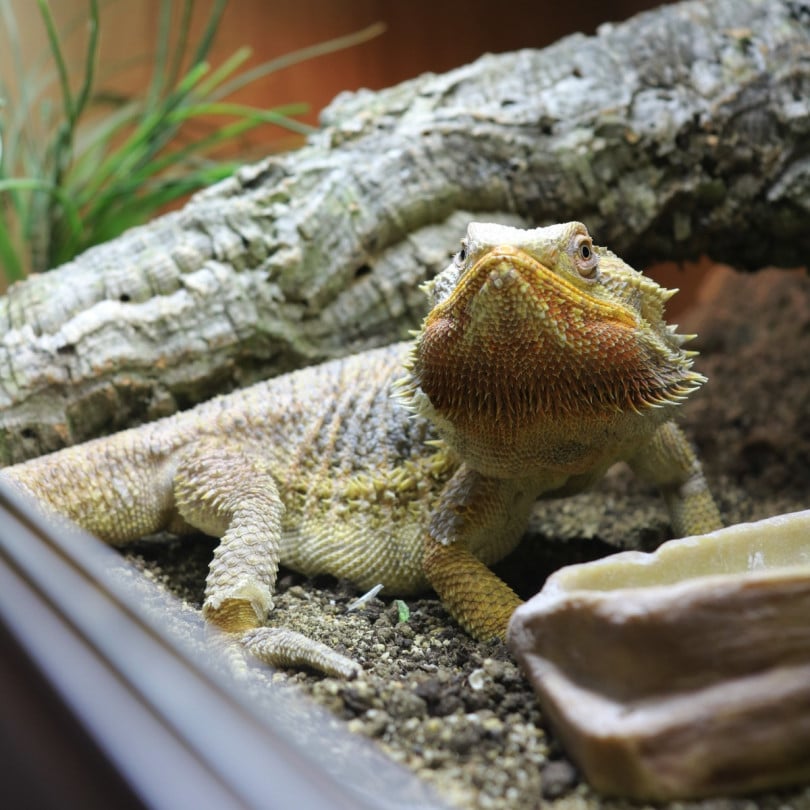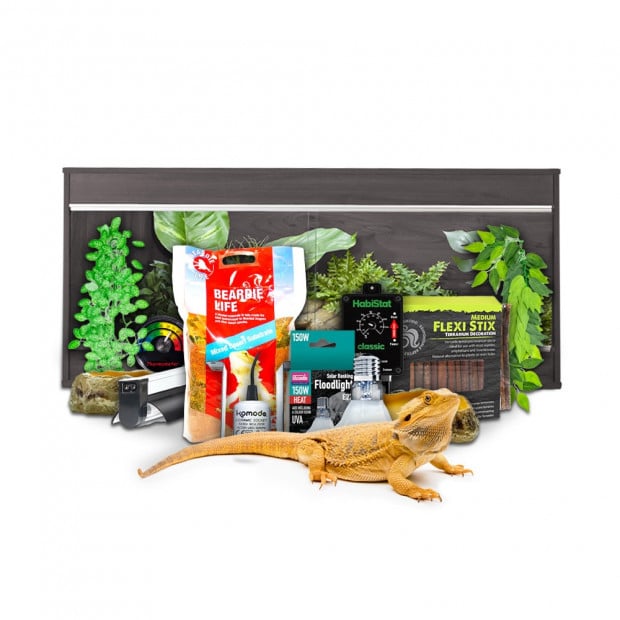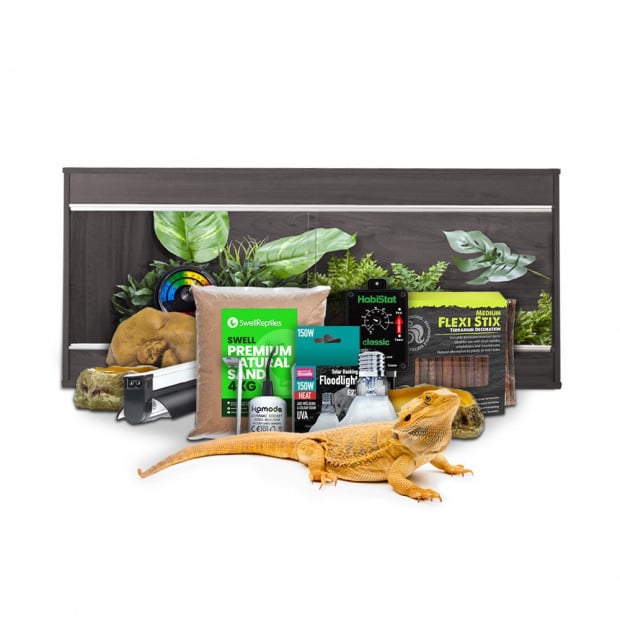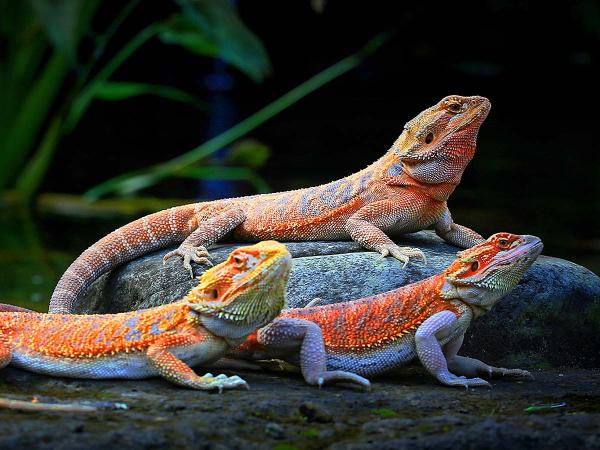-
Categories: Care sheetsLizards
Bearded dragon, Pogona vitticeps, care sheet
Bearded dragon, Pogona vitticeps, husbandry guide from the experts at Swell Reptiles, covering housing, heating, lighting and more.
Bearded dragon, Pogona vitticeps
A favourite for beginners and experienced keepers alike, the Bearded dragon

- Bearded dragons - the top beginner reptile
- Easy to handle and fun to spend time with
- Intelligent reptile that will quickly become part of the family
Do Bearded dragons make good pets?
Bearded dragons are one of the most popular reptiles kept as pets around the globe, and for good reason - they are intelligent, docile and easy to take care of. When kept with other individuals, Beardies, particularly males can become territorial, so should always be kept alone. Our Bearded dragons are all bred in the UK, although naturally they hail from the Australian outback and as such thrive in very high temperatures and low humidity, which is relatively easy to achieve with the correct equipment, all of which can be purchased from Swell Reptiles. To make things even easier, we offer a range of Bearded Dragon Starter Kits, suitable for juveniles all the way up to adulthood.
What enclosure does a Bearded dragon need?
Bearded dragons are decent-sized lizards that will appreciate lots of horizontal space with enough height to provide some elevated basking points. Wooden vivariums generally work the best due to their capacity to hold lots of heat, although glass or PVC enclosures can also work. At Swell Reptiles, we recommend a minimum adult enclosure size of 120 x 60 x 60cm (4 x 2 x 2ft) such as the VivExotic Repti-Home Bearded Dragon Vivarium Large, although if you can go bigger, this will always be better.
What heating equipment do I need for my Bearded dragon?
Being desert reptiles, Beardies thrive in high temperatures, preferring a basking spot of around 40-42°C (104-107°F) and a cool end somewhere in the mid-20s. This is usually achieved using heat bulbs, although can also be done using a ceramic heat emitter. Any heating equipment should always be used in conjunction with a compatible thermostat, so dimming thermostats for basking lamps or pulse thermostat for ceramic heaters.
Bearded dragons will not usually require any additional overnight heating, providing your home does not get colder than around 15°C (59°F). If overnight heating is required, this is best done using a non-light emitting heat source such as a ceramic heat emitter, but it is still better to have this set to a low, ambient temperature to mimic the natural drop in temperature when the sun sets.
It is important that an accurate thermometer or two is used to monitor the temperature within your Bearded dragon enclosure and identify any faults with heating equipment as early as possible. For this, we recommend the Swell Digital Thermal Hygrometer.
Which UV should I get for my Bearded dragon?
Bearded dragons are considered to be full sun baskers and as such require a high level of UVB to thrive and avoid serious health issues. This is best achieved using a T5 lighting system, with the percentage depending on the distance between the Beardy's highest basking point and the light itself.
If your light will be between 25-30cm (10-12”) from the highest basking point, then a 6% T5 Kit will suffice, if the light will be between 30-45cm (12-18”) away, an Arcadia ProT5 - 12% Desert Kit would be required, any higher than this and an Arcadia ProT5 - 14% Dragon Kit would be required, providing this is no higher than 60cm (24”) from the highest basking point. You can check the UVI at any given distance using a Solarmeter.
How do I decorate a Bearded dragon’s vivarium?
Bearded dragons are quite large-bodied lizards, so it is important when decorating their enclosure to ensure that any branches or platforms can hold their weight. In the wild, Beardies are semi-arboreal and can often be seen perching on low tree branches, therefore they will appreciate some robust branches and platforms to climb and perch on such as the HabiStat Cork Branch and the Komodo Basking Platform.
What do Bearded dragons eat?
Bearded dragons are omnivores, so the main portion of their diet should be made up of leafy greens and vegetation, but they do also require regular livefood, with young Beardies needing more livefood than adults. Your Bearded dragon’s diet should be supplemented appropriately to ensure they are getting all of the nutrition they need. For this, we recommend the use of a high-quality multivitamin on every feed, such as Arcadia EarthPro-A, a calcium plus magnesium supplement on every fourth feed, such as Arcadia CalciumPro Mg and finally, a vitamin D3 supplement on every eighth feed such as Arcadia EarthPro RevitaliseD3.
How do I buy a Bearded dragon?
If you like the look of a Bearded dragon, this will need to be collected from our store. If this is no problem for you, please pop down to see us in person where we will ask to see some images of your set-up with the correct temperatures and adequate UV lighting, and will ask you a few quick questions to ensure you are ready to adopt the animal. We reserve the right to refuse adoption to anyone we feel is unprepared to adopt.
For more detailed husbandry information, please refer to our Bearded dragon care sheet. If you're looking for an alternative to Bearded dragons, check out our Rankin's dragon care sheet.
| Common names | Bearded dragon, Beardie |
| Scientific name | Pogona vitticeps |
| Country | Australia |
| Captive-bred | Yes |
| Adult size | 61cm (2ft) |
| Natural habitat | Arid woodland, scrub, grassland and desert habitats |
| Housing | 120 x 60 x 60cm (4 x 2 x 2ft) |
| Ideal temperature | 40-42°C (104-107°F) (warm end); 25°C (77°F) (cool end) |
| UVI | 4-6 |
| Ideal humidity | 30-40% |
| Diet | Omnivorous |
| Average lifespan | 10-15 years |
| Personality | Docile |
| Ease of handling | Easy |
| Cohabitable | No |
-
 Rankin's dragon, Pogona henrylawsoniiFrom £120.00Out of stock
Rankin's dragon, Pogona henrylawsoniiFrom £120.00Out of stock -
 Ornate plated lizard, Zonosaurus ornatusFrom £60.00Out of stock
Ornate plated lizard, Zonosaurus ornatusFrom £60.00Out of stock -
 Desert collared lizard, Crotaphytus collarisFrom £195.00In stock
Desert collared lizard, Crotaphytus collarisFrom £195.00In stock








